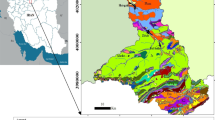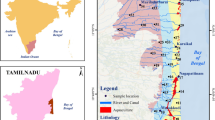Abstract
Coastal aquifers are at threat of salinization in most parts of the world. This work investigated the seasonal hydrochemical evolution of coastal groundwater resources in Urmia plain, NW Iran. Two recently proposed methods have been used to comparison, recognize and understand the temporal and spatial evolution of saltwater intrusion in a coastal alluvial aquifer. The study takes into account that saltwater intrusion is a dynamic process, and that seasonal variations in the balance of the aquifer cause changes in groundwater chemistry. Pattern diagrams, which constitute the outcome of several hydrochemical processes, have traditionally been used to characterize vulnerability to sea/saltwater intrusion. However, the formats of such diagrams do not facilitate the geospatial analysis of groundwater quality, thus limiting the ability of spatio-temporal mapping and monitoring. This deficiency calls for methodologies which can translate information from some diagrams such Piper diagram into a format that can be mapped spatially. Distribution of groundwater chemistry types in Urmia plain based on modified Piper diagram using GQIPiper(mix) and GQIPiper(dom) indices that Mixed Ca–Mg–Cl and Ca-HCO3 are the dominant water types in the wet and dry seasons, respectively. In this study, a groundwater quality index specific to seawater intrusion (GQISWI) was used to check its efficiency for the groundwater samples affected by Urmia hypersaline Lake, Iran. Analysis of the main processes, by means of the Hydrochemical Facies Evolution Diagram (HFE-Diagram), provides essential knowledge about the main hydrochemical processes. Subsequently, analysis of the spatial distribution of hydrochemical facies using heatmaps helps to identify the general state of the aquifer with respect to saltwater intrusion during different sampling periods. The HFE-D results appear to be very successful for differentiating variations through time in the salinization processes caused by saltwater intrusion into the aquifer, distinguishing the phase of saltwater intrusion from the phase of recovery, and their respective evolutions. Both GQI and HFE-D methods show that hydrochemical variations can be read in terms of the pattern of saltwater intrusion and groundwater quality status. But generally, in this case (i.e. saltwater and not seawater intrusion) the HFE-D method was presented better efficiency than GQI method (including GQIPiper and GQISWI).







Similar content being viewed by others
References
Abbaspour M, Javid AH, Mirbagheri SA, Ahmadi Givi F, Moghimi P (2012) Investigation of lake drying attributed to climate change. Intern J Environ Sci Technol 9:257–266
Al-Taani AA (2012) Seasonal variations in water quality of Al-Wehda Dam north of Jordan and water suitability for irrigation in summer. Arab J Geosci. doi:10.1007/s12517-011-0428-y
APHA (American Public Health Association) (1985) Standard methods of the examination of water/wastewater, 16th ed. APHA, AWWA, and WPCF, New York
Appelo CAJ, Postma D (2005) Geochemistry. CRC Press, Groundwater and Pollution
Badv K, Deriszadeh M (2005) Wellhead protection area delineation using the analytic element method. Water Air Soil Pollut 161:39–54
Bakhtiari A, Zeinoddini M, Tofighi MA (2011) Effects of inflow reduction on water level, morphology and salinity pattern of the Urmia Lake. J Hydraul 6(3):83–93 (in Persian)
Boluda-Botella N, Valdes-Abellan J, Pedraza R (2014) Applying reactive models to column experiments to assess the hydrogeochemistry of seawater intrusion: optimising ACUAINTRUSION and selecting cation exchange coefficients with PHREEQC. J Hydrol 510:59–69
Bouzourra H, Ra Bouhlila, Elango L, Slama F, Ouslati N (2014) Characterization of mechanisms and processes of groundwater salinization in irrigated coastal area using statistics, GIS, and hydrogeochemical investigations. Environ Sci Pollut Res. doi:10.1007/s11356-014-3428-0
Capaccioni B, Didero M, Paletta C, Didero L (2005) Saline intrusion and refreshening in a multilayer coastal aquifer in the Catania Plain (Sicily, Southern Italy): dynamics of degradation processes according to the hydrochemical characteristics of groundwaters. J Hydrol 307:1–16
Chen K, Jiao JJ (2014) Modeling freshening time and hydrochemical evolution of groundwater in coastal aquifers of Shenzhen, China. Environ Earth Sci 71:2409–2418
De Montety V, Radakovitch O, Vallet-coulomb C, Bernard Blavoux B, Hermitte D, Valle SV (2008) Origin of groundwater salinity and hydrogeochemical processes in a confined coastal aquifer: case of the Rhône delta (Southern France). Appl Geochem 23:2337–2349
Eimanifar A, Mohebbi F (2007) Urmia Lake (Northwest Iran): a brief review. Saline Syst 3:5. doi:10.1186/1746-1448-3-5
El Yaouti F, El Mandour A, Khattach D, Benavente J, Kaufmann O (2009) Salinization processes in the unconfined aquifer of Bou-Areg (NE Morocco): a geostatistical, geochemical, and tomographic study. Appl Geochem 24:16–31
Ghiglieri G, Carletti A, Pittalis D (2012) Analysis of salinization processes in the coastal carbonate aquifer of Porto Torres (NW Sardinia, Italy). J Hydrol 432–433:43–51
Gibbs MS, Dandy GC, Maier HR (2013) Assessment of the ability to meet environmental water requirements in the Upper South East of South Australia. Stoch Environ Res Risk Assess. doi:10.1007/s00477-013-0735-9
Giménez-Forcada E (2010) Dynamic of seawater interface using hydrochemical facies evolution diagram. Ground Water 48(2):212–216
Hassanzadeh E, Zarghami M, Hassanzadeh Y (2011) Determining the main factors in declining the Urmia Lake level by using system dynamics modeling. Water Resour Manag 26(1):129–145
Hoseinpour M, Fakheri Fard A, Naghili R (2010) Death of Urmia Lake, a silent disaster investigating causes, results and solutions of Urmia Lake drying. Paper presented at the 1st international applied geological congress, Department of Geology, Islamic Azad University, Islamic Azad University-Mashad Branch, Iran
Huang J, Ho M, Du P (2011) Assessment of temporal and spatial variation of coastal water quality and source identification along Macau peninsula. Stoch Environ Res Risk Assess 25(3):353–361
ISO (International Standards Organisation) (1993) Water quality-sampling -part 11: Guidance on sampling of ground waters. ISO 5667-11
Kashouty ME, Aziz AA, Soliman M, Mesbah H (2012) Hydrogeophysical investigation of groundwater potential in the El Bawiti, Northern Bahariya Oasis, Western Desert, Egypt. Arab J Geosci 5:953–970
Ketata M, Gueddari M, Bouhlila R (2012) Use of geographical information system and water quality index to assess groundwater quality in El Khairat deep aquifer (Enfidha, Central East Tunisia). Arab J Geosci 5:1379–1390
Lucas Y, Schmitt AD, Chabaux F, Clément A, Fritz B, Elsass Ph, Durand S (2010) Geochemical tracing and hydrogeochemical modelling of water-rock interactions during salinization of alluvial groundwater (Upper Rhine Valley, France). Appl Geochem 25:1644–1663
Marie A, Vengosh A (2001) Sources of salinity in groundwater from Jericho area, Jordan valley. Ground Water 39:240–248
Marjani A, Jamali M (2014) Role of exchange flow in salt water balance of Urmia Lake. Dyn Atmos Ocean 65:1–16
Ministry of Energy (2010) Integrated management plan for Lake Urmia Basin. Internal report
Misut PE, Voss CI (2007) Freshwater-saltwater transition zone movement during aquifer storage and recovery cycles in Brooklyn and Queens, New York City, USA. J Hydrol 337:87–103
Mollema PN, Antonellini M, Dinelli E, Gabbianelli G, Greggio N, Stuyfzand PJ (2013) Hydrochemical and physical processes influencing salinization and freshening in Mediterranean low-lying coastal environments. Appl Geochem 34:207–221
Mustapha A, Aris AZ, Juahir H, Ramli MF (2012) Surface water quality contamination source apportionment and physicochemical characterization at the upper section of the Jakara Basin, Nigeria. Arab J Geosci. doi:10.1007/s12517-012-0731-2
NOAA (National Oceanic and Atmospheric Administration). “Oroomieh climate normals 1961–1990”. Retrieved 27 Dec 2012
Panteleit B, Hamer K, Kringel R, Kessels W, Schulz HD (2011) Geochemical processes in the saltwater-freshwater transition zone: comparing results of a sand tank experiment with field data. Environ Earth Sci 62:77–91
Perera EDP, Jinno K, Tsutsumi A, Hiroshiro Y (2009) Numerical study of salinity variation in a coastal aquifer: a case study of the Motooka region in western Japan. Stoch Environ Res Risk Assess 23:957–965
Pradhan B (2009) Ground water potential zonation for basaltic watersheds using satellite remote sensing data and GIS techniques. Central Eur J Geosci 1:120–129
Pradhan B, Pirasteh S (2011) Hydro-chemical analysis of the groundwater of the Basaltic catchments: upper Bhatsai Region, Maharastra. Open Hydrol J 5:51–57
Qahman K, Larabi A, Ouazar D, Naji A, Alexander H, Cheng D (2005) Optimal and sustainable extraction of groundwater in coastal aquifers. Stoch Environ Res Risk Assess 19:99–110
Ravikumar P, Somashekar RK (2011) A geochemical assessment of coastal groundwater quality in the Varahi river basin, Udupi District, Karnataka State, India. Arab J Geosci. doi:10.1007/s12517-011-0470-9
Reveshty M, Maruyama Y (2010) Study of Uremia Lake level fluctuations and predict probable changes using multi- temporal satellite images and ground truth data period (1976–2010). Paper presented at the Map Asia 2010 and ISG 2010, Kuala Lumpur, Malaysia
Sarath Prasanth S, Magesh N, Jitheshlal K, Chandrasekar N, Gangadhar K (2012) Evaluation of groundwater quality and its suitability for drinking and agricultural use in the coastal stretch of alappuzha district, kerala, india. Appl Water Sci 2(3):165–175
Subramani T, Elango L, Damodarasamy S (2005) Groundwater quality and its suitability for drinking and agricultural use in Chithar River Basin, Tamil Nadu, India. Environ Geol 47(8):1099–1110
Tomaszkiewicz M, Abou Najm M, El-Fadel M (2014) Development of a groundwater quality index for seawater intrusion in coastal aquifers. Environ Model Softw 57:13–26
Vengosh A (2003) Salinization and saline environments. In: Sherwood Lollar, B. (Ed.), Environmental geochemistry. Treatise on geochemistry 9 (Holland, H.D., Turekian, K.K., Exec. Eds.), Elsevier, pp 333–365
Wada Y, van Beek L, van Kempen C, Reckman J, Vasak S, Bierkens M (2010) Global depletion of groundwater resources. Geophysical research letters 37(20) http://dx.doi.org/10.1029/2010gl044571
WMO (World Meteorological Organisation) (2014) http://worldweather.wmo.int/en/city.html?cityId=1454
Zghibi A, Merzougui A, Zouhri L, Tarhouni J (2013) Interaction between groundwater and seawater in the coastal aquifer of Cap-Bon in the semi-arid systems (north-east of Tunisia). Carbonates Evaporites. doi:10.1007/s13146-013-0181-2
Acknowledgments
The authors would like to thank the corresponding people in the Geological Survey of Iran (GSI) for the financial support which helped to carry out this research work.
Compliance with Ethical Standards
This study was funded by the Geological Survey of Iran (GSI). The authors declare that they have no conflict of interest. For this type of study formal consent is not required. This article does not contain any studies with human participants or animals performed by any of the authors.
Author information
Authors and Affiliations
Corresponding author
Rights and permissions
About this article
Cite this article
Amiri, V., Nakhaei, M., Lak, R. et al. Assessment of seasonal groundwater quality and potential saltwater intrusion: a study case in Urmia coastal aquifer (NW Iran) using the groundwater quality index (GQI) and hydrochemical facies evolution diagram (HFE-D). Stoch Environ Res Risk Assess 30, 1473–1484 (2016). https://doi.org/10.1007/s00477-015-1108-3
Published:
Issue Date:
DOI: https://doi.org/10.1007/s00477-015-1108-3




